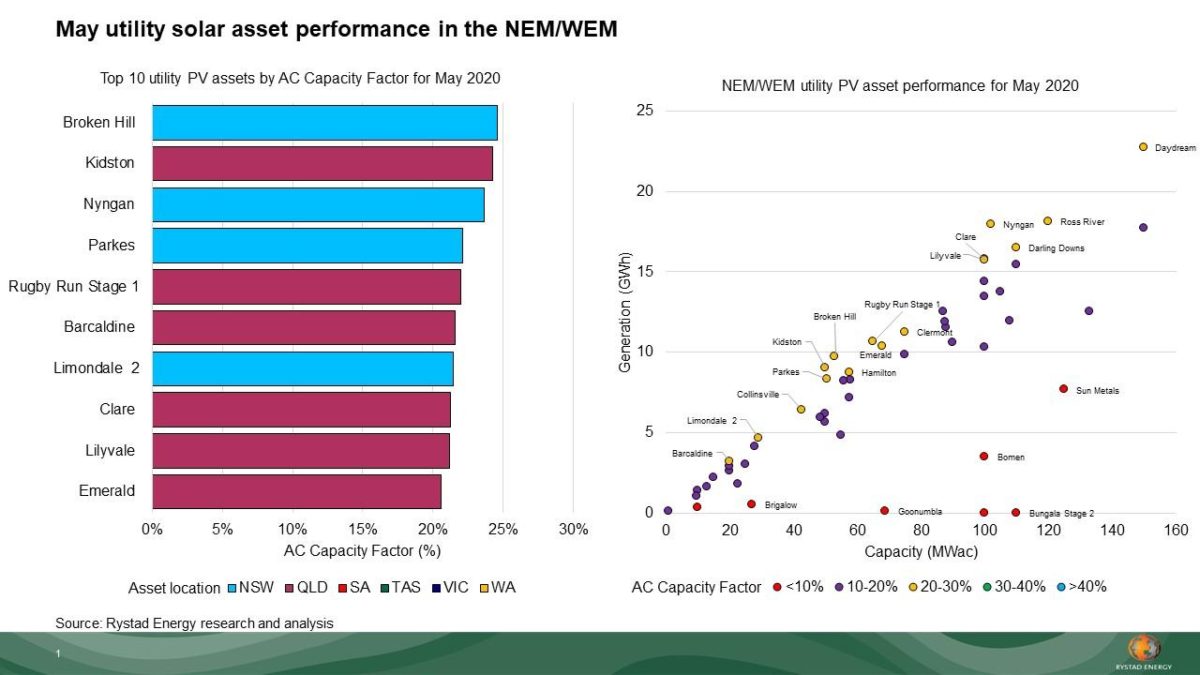One of the five solar farms in the West Murray Zone (WMZ), which had their output radically curtailed to 50% for seven months, the Broken Hill Solar Farm has emerged stronger than ever. After generation constraints in the region had been provisionally lifted in late April, the 53 MW project recorded the highest AC CF (24.6%) of any utility-scale PV asset in the country last month, according to data compiled by Norwegian consultancy Rystad Energy.
Aside from being heavily impacted by the WMZ system strength saga, the Broken Hill Solar Farm is often referred to as one of the projects most severely hit by transmission losses i.e. Marginal Loss Factors (MLFs). After other generators connected nearby, the Broken Hill project saw its MLF reduced from above 1 in 2016 to 0.73 in 2019-20 – a drop of more than 40%. In AEMO’s final MLF report for 2020-21, Broken Hill was the worst affected project in the NEM, with MLFs as low as 0.78.
However, after constraints were lifted in the WMZ, Broken Hill really bounced back in May in terms of its capacity factor. The other four projects located in Victoria experienced improvements to a smaller extent. David Dixon, Senior Analyst at Rystad Energy, tells pv magazine Australia that this is because there are also other factors at play, such as a resource difference.
“The Broken Hill project has better irradiance this time of year than those further south,” Dixon says. “Also, it is fixed tilt and those further south are featuring single axis trackers. Fixed tilt assets won’t have as much of a reduction in CF in the winter months as those with single axis trackers.”
Occupying a site about five kilometers southwest of the mining town of Broken Hill, the 53 MW project was one of Australia’s first large-scale PV power plants. It was delivered by AGL in 2015 and jointly funded by the Australian Renewable Energy Agency (ARENA) and the NSW Government.
Today, the Broken Hill Solar Farm is part of AGL Energy’s Powering Australian Renewables Fund (PARF), developed in partnership with Queensland Investment Corp (QIC). PARF aims to deliver and own approximately 1,000 MW in large-scale renewable projects through its $2-3 billion pockets.
Top generator by equity ownership
May was a great month for PARF, according to Rystad’s data, which emerged as the largest combined utility-scale PV/wind generator in Australia. PARF’s other PV project – the 102 MW Nyngan Solar Farm in western NSW – was the third best performing utility PV asset in May with an AC CF of 23.7%.
Restrictions were lifted at PARF’s Silverton wind farm, which was the fourth best-performing wind farm in May (41.8% CF), whilst the 453 MW Coopers Gap continued to proceed through commissioning, generating 95 GWh in May up from 48 GWh in April.
Other top performing utility PV assets in May included the Genex Power-owned Kidston Solar Farm in Queensland (24.3% AC CF) and Neoen’s Parkes Solar Farm in NSW (22.1% AC CF). As for the top-performing wind assets in May, the list included Electricity Generating Public Company Limited’s (EGCO) Boco Rock wind farm in NSW (48% CF), APA Group’s Badgingarra wind farm in WA (42.8% CF) and John Laing’s Kiata wind farm in Victoria (41.8% CF).
Overall, renewables contributed over 26% to the Australian National Electricity Market (NEM) and approximately 20% to the Wholesale Electricity Market (WEM) in May, Rystad finds. In recent months, the share of renewable energy in the NEM has been at around 25% and has occasionally for brief periods exceeded 50%, most notably on Easter Saturday. This was the first time that this mark has been achieved over a period of more than a few minutes, that is for nearly two hours.
In total, the NEM has 17 GW of wind and solar generation capacity, according to AEMO data, with several regions among the world’s highest levels of wind and solar penetration, including one of the highest levels of residential PV. In a recent study, AEMO found that the country already has the technical capability to safely operate a system where 75% of electricity comes from wind and solar, but to do so it needs to get regulations right.
This content is protected by copyright and may not be reused. If you want to cooperate with us and would like to reuse some of our content, please contact: editors@pv-magazine.com.









Very impressed with this great achievement, congratulations to the team.